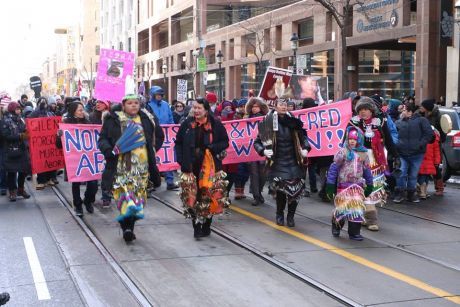Reports
You are here
Justice for murdered and missing Indigenous women: ten years on

February 17, 2015
February 14 marked the tenth anniversary of cross-country vigils commemorating the lives of missing and murdered Indigenous women. In Toronto over 400 people attended the event held in the courtyard of the downtown police station.
The MC noted that little justice has been obtained over the last ten years, citing the horrible death of teen Tina Fontaine in Winnipeg, and other women in the last year. So the call remains for justice and understanding.
The vigil included important symbols of water and strawberries, which were distributed to participants as a way of providing strength in the struggle. Water is valued because it is the only element that gives, sustains and can take away life. Participants poured a small amount of the water into the ground, to sustain the Earth, and drank the rest. Other participants ate the strawberries, whose symbolic importance stems from the fact that although strawberries may appear to be separated while growing on the ground, they are connected by a strong root system underneath. In a similar way, we are all connected in some way to the missing and murdered Indigenous women.
Speakers criticized Harper’s funding cuts to women’s organizations. “He doesn’t want us out protesting. But they didn’t say anything about holding ceremonies”, the MC noted with a smile.
A number of survivor family members spoke. One woman from the Gitxsan nation in northern BC noted that the Highway of Tears remains a danger zone for Indigenous women. She also noted the tremendous brutality faced by Indigenous men at the hands of police. “We are powerful when we come together” she stated.
Another speaker was a grandmother of a victim. She pointed out that Indigenous women have been missing and murdered since the time of fur traders, who routinely kidnapped women. She said “I refuse to be called a terrorist. I’m a protester.”
The vigil ended with the MC calling on all of us to send a message around the world: “No more!”
The participants then went on a march, stopping traffic along Yonge Street, Toronto’s main thoroughfare. The group stopped twice to hold brief round dances, with drumming and singing. The mood was defiant and proud.
With the leadership of Indigenous women, the rest of the country can respond in solidarity. We need to step up the continuing support from faith groups, trade unions, women’s organizations and others, so that ten years from now we are not still having to see the tragic and unfair numbers of missing and murdered Indigenous women.
Section:










